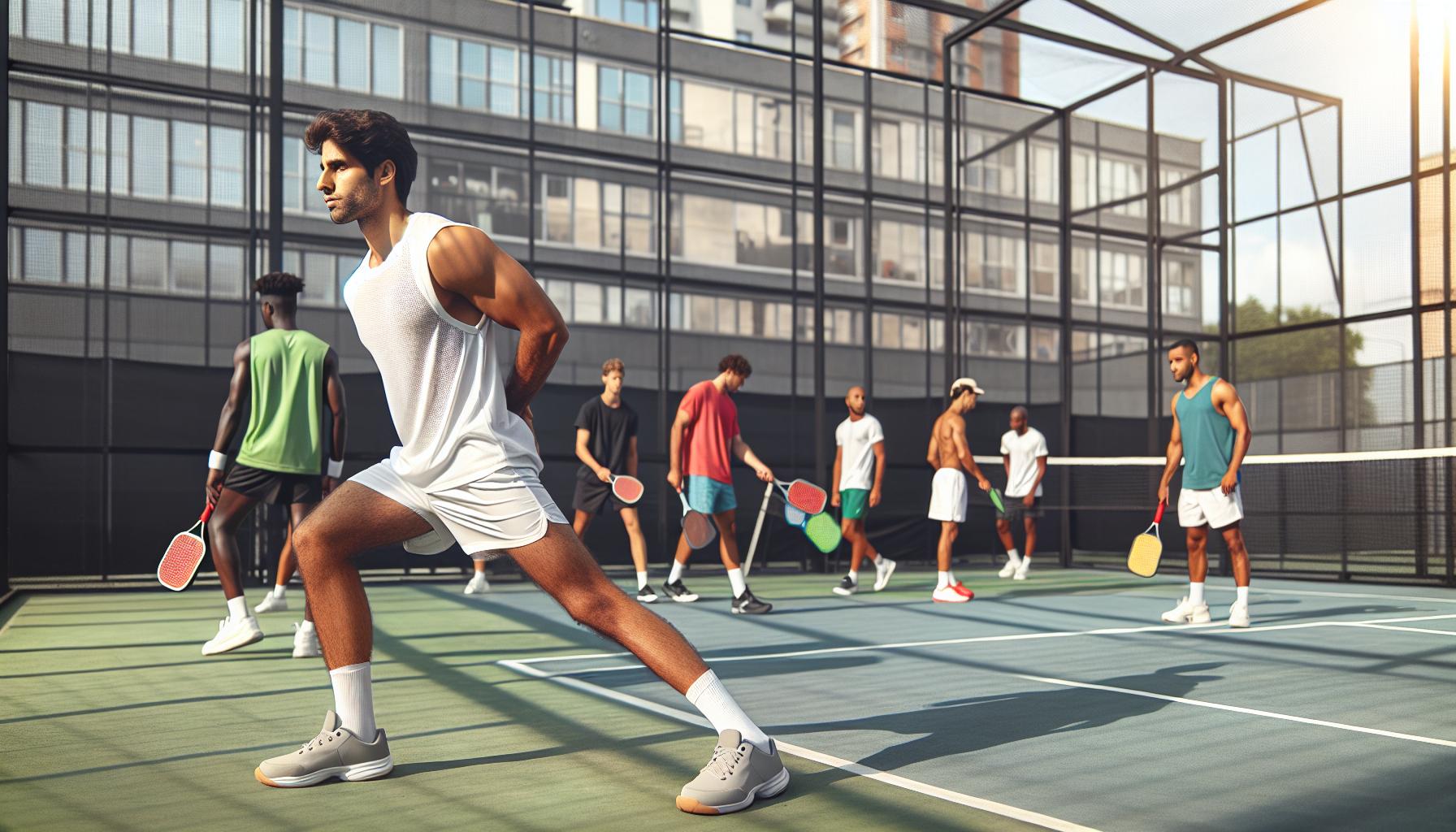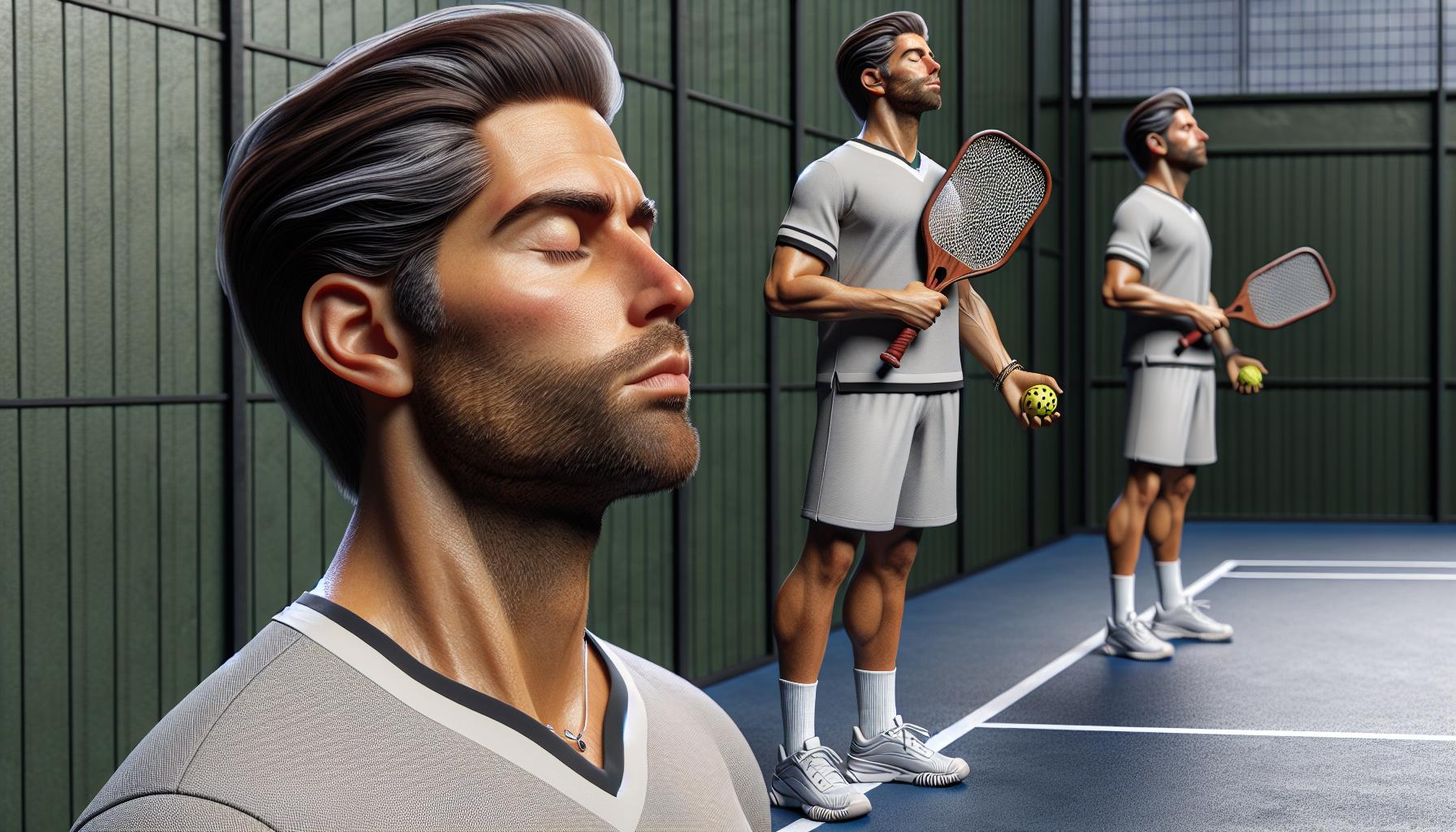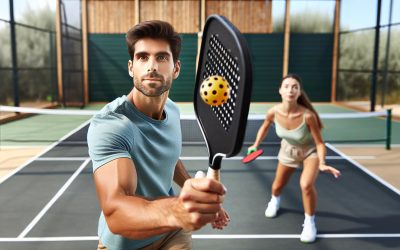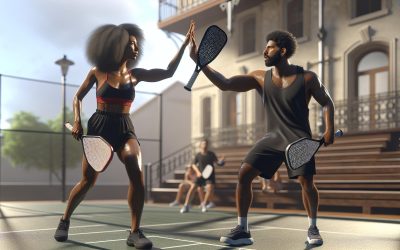Pickleball’s skyrocketing popularity isn’t just a testament to its fun, engaging nature but also to the physical demands it places on players. Whether you’re a seasoned pro or just picking up a paddle, the importance of a solid warm-up routine can’t be overstated. It’s the unsung hero in your quest to stay injury-free on the court.
Crafting a warm-up routine tailored for pickleball isn’t just about getting your heart rate up. It’s about preparing your muscles, joints, and mind for the game’s unique blend of quick movements, strategic plays, and endurance. Let’s dive into how you can create a warm-up routine that not only boosts your performance but also shields you from injuries, ensuring that you can enjoy the game for years to come.
Why warm-up routines are important for pickleball
Pickleball, a rapidly growing sport, combines elements of tennis, badminton, and table tennis into a game that’s both accessible and physically demanding. As players engage in quick volleys, strategic positioning, and sudden direction changes, the importance of a thorough warm-up cannot be overstated. Warm-up routines are vital in preparing the body and mind for the game’s rigors, significantly impacting performance and injury prevention.
Injury prevention stands at the forefront of why warm-ups are crucial. Pickleball demands a lot from the body – quick starts, stops, and lateral movements are integral to gameplay. These movements can strain muscles and joints, particularly if they’re not properly prepared. A well-structured warm-up increases blood flow to the muscles, enhances flexibility, and prepares the joints for movement, which in turn, reduces the risk of strains, sprains, and other injuries.
Beyond injury prevention, warm-ups play a pivotal role in enhancing athletic performance. Pre-game routines activate the neurological pathways between the brain and muscles, sharpening coordination and reaction times. This neurological activation is especially important in a fast-paced game like pickleball, where split-second decisions can make or break a play. Additionally, warming up elevates the heart rate gradually, ensuring that players don’t expend their energy reserves too quickly, thereby improving endurance and overall performance on the court.
Moreover, the mental benefits of a dedicated warm-up routine are often overlooked. Engaging in specific exercises before a match can help players focus, reduce anxiety, and mentally strategize for the game ahead. This pre-game mental prep aligns players’ minds with their bodies, setting the stage for a cohesive and focused performance.
Incorporating dynamic stretching, light cardiovascular exercises, and sport-specific drills into a warm-up routine ensures that players are comprehensively prepared. Movements that mimic those in pickleball, such as lateral shuffles, gentle lunges, and arm circles, are particularly beneficial. These activities not only prime the body for physical exertion but also hone the skills and techniques that are crucial for success in the game.
Understanding the physical demands of pickleball

Pickleball is not just a leisurely backyard sport; it’s a dynamic activity that tests players’ limits through its quick-paced nature and strategic gameplay. Those new to the sport might be surprised by its physicality, demanding a blend of agility, strength, and endurance. Understanding these demands is crucial for tailoring an effective warm-up routine to prevent injuries and boost performance.
First and foremost, pickleball requires swift and frequent changes in direction. This aspect of the game puts considerable stress on the ankles and knees, making it essential to prepare these joints for action. Dynamic stretches that mimic game movements can increase flexibility and reduce the risk of sprains or strains.
In addition to agility, pickleball players need a good deal of endurance. The game involves prolonged periods of play with minimal breaks, requiring a steady supply of energy. Light cardiovascular exercises, such as jogging or cycling, can be beneficial in the warm-up phase. These activities gradually increase the heart rate and blood flow, ensuring muscles are well-oxygenated and ready for the demands of the game.
Upper body strength also plays a pivotal role in pickleball. The sport’s unique paddle and ball require precise movements for effective strikes. Warm-ups focusing on the shoulders, arms, and wrists are crucial. Arm circles, wrist flexions, and shoulder stretches can prepare these areas for the repetitive motions seen in serving and volleying.
Another critical aspect is the coordination and reaction time needed to play pickleball effectively. The game’s fast pace requires players to anticipate their opponent’s moves and react quickly to return the ball. Drills that simulate game scenarios, such as quick lateral movements or sudden starts and stops, can sharpen these skills. They also activate neurological pathways, enhancing muscle memory and coordination.
Lastly, pickleball has a significant mental component. Players must remain focused and strategize while physically engaged. Warm-up routines that incorporate mental preparation, such as visualization or strategic planning, can help players enter the game with a clear, focused mind. This mental readiness is just as critical as physical preparedness.
Components of an effective warm-up routine
Warm-ups play a crucial role in preparing the body and mind for the rigors of pickleball, a sport that demands agility, quick reflexes, and stamina. To ensure a warm-up routine is as effective as possible, it should include several key components that target different aspects of physical and mental readiness.
Dynamic Stretches
Starting with dynamic stretches primes the muscles for the activity ahead. Unlike static stretches, which involve holding a position for a long period, dynamic stretches incorporate movement. This not only warms up the muscles but also enhances joint mobility, crucial for the swift, multidirectional movements typical in a pickleball game. Examples of beneficial dynamic stretches for pickleball players include arm circles, leg swings, and gentle torso twists.
Cardiovascular Activities
A light cardiovascular workout raises the heart rate and increases blood flow to the muscles, preparing them for the intense activity to come. Activities like jogging in place, jumping jacks, or a brisk walk around the court can serve this purpose without exhausting the player before the game even begins. This escalation in heart rate and circulation is also beneficial for the gradual preparation of the cardiovascular system, reducing the risk of sudden strain during the game.
Pickleball-Specific Drills
Incorporating sport-specific drills into the warm-up routine familiarizes the body with the movements and scenarios encountered during actual gameplay. Drills that mimic the game’s common plays and movements can significantly improve coordination and reaction time. For example, practicing serve motions, gentle rallies, or footwork drills not only warms up the body but also sharpens the mind’s ability to strategize and anticipate.
Mental Preparation
An often-overlooked aspect of warm-ups is mental readiness. Visualization exercises, positive self-talk, or simply strategizing for the game can mentally prime players for competition. This mental prep helps in reducing pre-game anxiety, improving focus, and boosting confidence on the court.
Flexibility and Balance Exercises
Given the quick, sudden movements and the need for balance and precision in pickleball, incorporating flexibility and balance exercises into warm-up routines can be highly beneficial. Exercises like yoga poses focused on balance, or Pilates movements that enhance core strength, can improve a player’s stability and flexibility on the court.
Dynamic stretching exercises for pickleball warm-up

Incorporating dynamic stretching exercises into a pickleball warm-up routine can significantly reduce the risk of injuries and enhance performance on the court. Unlike static stretches that involve holding a position, dynamic stretches involve movement and are particularly effective in preparing the body for the type of activity it’s about to undertake. These stretches not only improve flexibility and increase muscle temperature but also activate the muscles and neurological pathways that are utilized during gameplay.
A comprehensive warm-up routine for pickleball players should include a variety of dynamic stretches that target the key muscle groups involved in the sport. These stretches aim to mimic the movements of the game, thus preparing the body for the quick starts, stops, and directional changes characteristic of pickleball.
Upper Body Dynamic Stretches
Given the importance of arm movements in serving and volleying, upper body stretches are crucial. Some effective exercises include:
- Arm Circles: Extend the arms out to the sides and perform small to large circular motions. This helps warm up the shoulders and improves range of motion.
- Torso Twists: With feet hip-width apart, twist the torso from side to side. This motion warms up the core muscles and helps improve flexibility in the upper body.
Lower Body Dynamic Stretches
Pickleball requires sudden movements and quick footwork, making lower body stretches equally important. Some recommended exercises are:
- Leg Swings: Hold onto a fence or wall for support and swing one leg forward and back, then side to side. This exercise warms up the hips, thighs, and hamstrings.
- Lunges with a Twist: Perform a forward lunge and add a twist toward the front leg. This engages the leg muscles while also targeting the torso and aiding in mobility.
Core and Agility Drills
A strong core is essential for stability and power in pickleball. Incorporating movement-based stretches that also enhance agility is beneficial. Drills such as:
- High Knees: Running on the spot with knees lifting high engages the core and increases heart rate.
- Butt Kicks: Jogging on the spot while trying to kick the buttocks with the heels activates the hamstrings and improves flexibility.
- Shadow Playing: Mimicking pickleball strokes and
Cardiovascular exercises for pickleball warm-up

Initiating a pickleball game without adequately warming up the cardiovascular system is akin to driving a car in winter without letting the engine warm up. It doesn’t just increase the likelihood of performance hiccups but can also lead to potential injuries. Therefore, incorporating cardiovascular exercises into the warm-up routine is indispensable for pickleball players. These exercises gradually increase the heart rate and blood circulation, ensuring that the muscles receive the oxygen and nutrients they need to perform optimally.
Starting with light jogging or brisk walking around the court can be an excellent way to get the blood flowing. This activity is accessible, doesn’t require any additional equipment, and effectively elevates the heart rate, making it a practical choice for players at any level. Following this, engaging in jumping jacks or skipping rope can further amplify the heart rate, improve footwork agility, and enhance coordination, all of which are essential for navigating the court successfully.
Suggested Cardiovascular Warm-up Circuit
To streamline the warm-up process, here’s a simple circuit that players can follow to ensure they’re sufficiently warmed up and ready to hit the court with their best game:
- 3 Minutes of Light Jogging or Brisk Walking
- Increases blood flow
- Elevates heart rate gradually
- 2 Minutes of Jumping Jacks
- Enhances agility
- Improves coordination
- 2 Minutes of Skipping Rope
- Boosts footwork speed
- Elevates heart rate further
- 1 Minute of High Knees
- Activates hip flexors and leg muscles
- Prepares the body for quick movements
Incorporating these exercises into a warm-up routine doesn’t just prime the body for physical activity but also gears up the mind, setting a focused and energetic tone for the game ahead.
| Exercise | Duration | Primary Benefits |
|---|---|---|
| Light Jogging | 3 minutes | Increases blood flow, elevates heart rate |
| Jumping Jacks | 2 minutes | Enhances agility, improves coordination |
| Skipping Rope | 2 minutes | Boosts footwork speed, elevates heart rate |
| High Knees | 1 minute | Activates hip flexors and leg muscles |
Mental preparation techniques for pickleball warm-up

In addition to the physical aspects of warming up for a pickleball game, mental preparation is equally crucial. This segment of the warm-up routine focuses on readying the mind for the challenges ahead, helping players reduce anxiety, enhance concentration, and improve game strategy.
One effective technique is visualization. Players can take a few moments to close their eyes and imagine themselves successfully executing plays, shots, and strategies. This not only boosts confidence but also helps in mentally rehearsing the physical movements, thereby enhancing muscle memory. Visualization can encompass everything from serving with precision to moving quickly and efficiently across the court.
Another important mental preparation technique involves setting clear, achievable goals for the game. Players should take time to reflect on what they wish to accomplish, whether it’s improving their serve accuracy, mastering a new shot, or simply staying positive throughout the game. Goals should be specific, measurable, achievable, relevant, and time-bound (SMART). Having clear objectives in mind can significantly improve focus and drive during the game.
Breathing exercises also play a pivotal role in mental preparation. Deep, controlled breathing can help lower heart rate and reduce pre-game jitters. Players might find it beneficial to incorporate a few minutes of mindful breathing into their warm-up, focusing on inhaling slowly through the nose and exhaling through the mouth. This practice not only calms the mind but also optimizes oxygen flow to the muscles, preparing the body for physical exertion.
Lastly, engaging in positive self-talk is a powerful tool for mental preparation. Players should consciously shift their inner dialogue to be supportive and encouraging, counteracting any negative thoughts or doubts that arise. Phrases like “I’ve got this,” “I am prepared,” and “I can handle whatever comes my way” can reinforce self-belief and mental resilience.
Incorporating these mental preparation techniques into pickleball warm-up routines can greatly enhance a player’s readiness, both physically and mentally. While the physical warm-up prepares the body for the rigors of the game, mental techniques ready the mind for peak performance, creating a comprehensive preparation strategy that addresses all facets of the sport. By prioritizing mental preparation, players can step onto the court with confidence, ready to tackle the challenges and opportunities that the game of pickleball presents.
Tips for creating a personalized warm-up routine
Crafting a personalized warm-up routine for pickleball shouldn’t be a one-size-fits-all solution. Every player has unique physical capabilities, limitations, and specific goals that should guide their warm-up routines. Personalizing one’s approach can significantly enhance injury prevention, performance, and overall enjoyment of the game.
First and foremost, assessing personal needs is crucial. Players should consider their injury history, areas of tightness or discomfort, and aspects of the game they find particularly challenging. For instance, someone with a history of ankle injuries might focus on exercises that improve ankle stability and mobility. This tailored approach ensures that players address their specific vulnerabilities, preparing their bodies more effectively for the demands of the game.
Incorporating a variety of exercises that target flexibility, strength, agility, and cardiovascular health is also essential. A comprehensive warm-up routine activates various muscle groups and prepares the body for the dynamic movements of pickleball. Dynamic stretches that mimic game movements can be particularly effective. For flexibility and agility, high knees and lateral lunges make excellent choices. To build strength, bodyweight exercises such as squats and lunges can be integrated. For cardiovascular health, short bursts of high-intensity exercises like sprints or jumping jacks will elevate heart rate and improve endurance.
Personalization also means considering the time of day and environmental conditions. Morning routines might require more time to ease into movements due to overnight muscle stiffness. Warmer temperatures may require shorter warm-up times to prevent overheating, whereas colder conditions might demand longer periods to ensure the muscles are adequately warmed up. Listening to one’s body and adjusting the routine based on these factors can prevent injuries and enhance performance.
Feedback and adjustment are part of creating an effective, personalized warm-up routine. Players should monitor how their bodies respond to different exercises and adjust their routines accordingly. If certain movements lead to discomfort or don’t seem to prepare the player well for the game, it’s wise to replace them with more effective alternatives. This iterative process ensures that the warm-up routine evolves in line with the player’s developing skills and physical condition.
Conclusion
Embracing a well-rounded warm-up routine before hitting the pickleball court isn’t just about preventing injuries—it’s about setting the stage for peak performance. By integrating dynamic stretches, cardiovascular exercises, and mental preparation techniques, players ensure they’re not only physically but also mentally ready for the game. It’s clear that taking the time to warm up properly pays off in enhanced agility, endurance, coordination, and focus. Tailoring this routine to individual needs and conditions further maximizes its effectiveness. So next time before the game begins, remember the power of a good warm-up. It’s your first step towards a winning performance on the pickleball court.














0 Comments